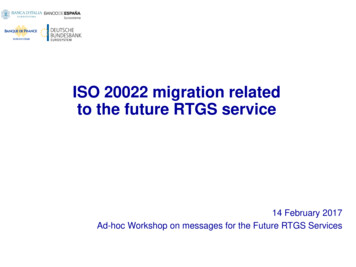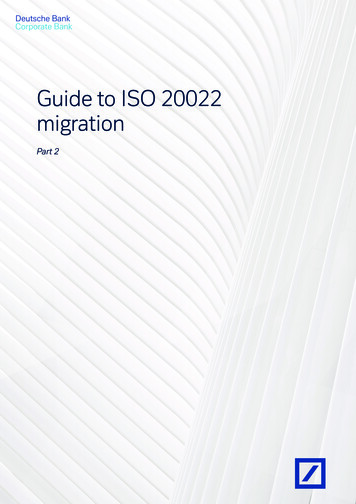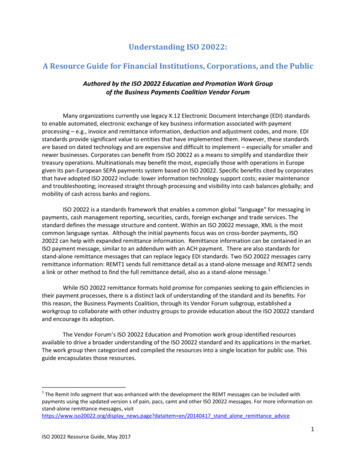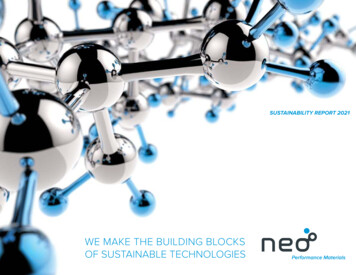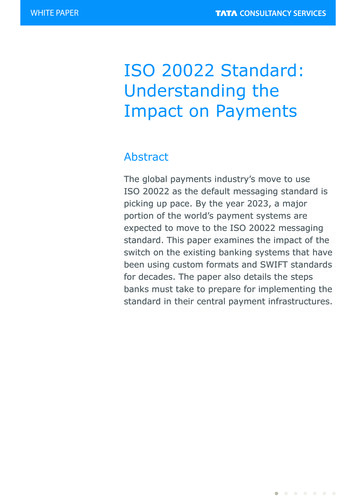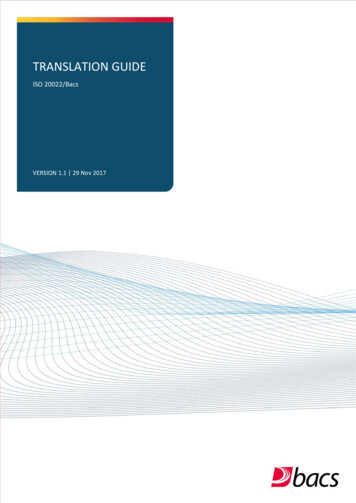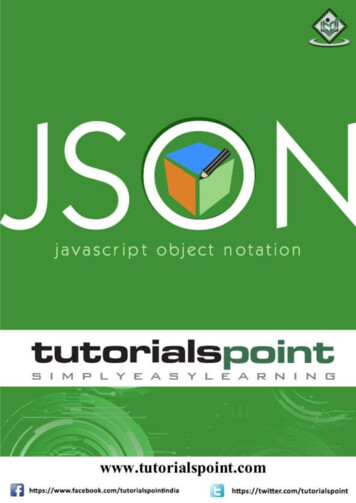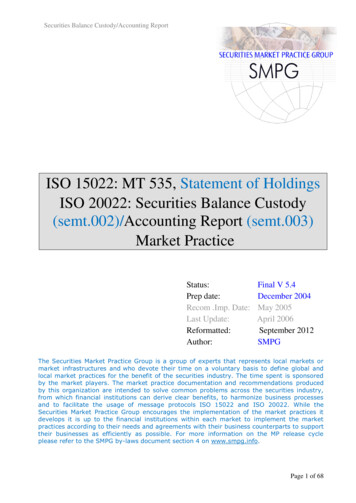
Transcription
ISO 20022 and JSON: An Implementation Best Practices WhitepaperISO 20022 and JSON: An Implementation Best Practices WhitepaperJanuary 2018By members of the ISO 20022 Registration Management Group and the Technical Support GroupApproved for publication by the ISO 20022 RMG 29 January, 2018This Whitepaper is a static document designed to provide an illustrative ‘best practice’ and to assistimplementers in the financial services industry define RESTful Web Service Application ProgrammingInterfaces (API). The ISO 20022 RMG or its Technical Support Group do not accept liability for its use.The document is illustrative and should be treated as such. 2018 – All rights reserved. ISO 20022 Registration Management Group
ISO 20022 and JSON: An Implementation Best Practices WhitepaperContentsForeword . ivIntroduction. v1Scope . 12Normative references . 13Terms and definitions. 244.14.24.2.14.2.24.2.34.2.44.3What is Representational State Transfer (REST)?. 3Introduction . 3Uniform interface . 3Resource-Based. 3Manipulation of Resources through Representations . 3Self-descriptive Messages. 3Hypermedia as the Engine of Application State (HATEOAS) . 3Stateless sessions . SO 20022 Web services . 4Introduction . 4Scope level. 5ISO 20022 metamodel . 5Modeling guidelines . 5Conceptual Level . 6ISO 20022 metamodel . 6Modeling guidelines . 7Logical Level . 8Introduction . 8Metamodel . 9Modeling guidelines . 56.3.6Implementation tutorial . 11Introduction . 11Composition of the URI . 11Apply the standard HTTP methods . 12Handling associations between resources . 13Request parameter usage. 13The response . 16Object and status . 16Success vs errors. 16The error element . 17Suppressing HTTP status codes . 19Pagination responses . 19Empty list. 1977.17.2Naming Conventions . 20Names . 20Single element versus collections of elements . 208Version control. 2099.19.29.39.49.59.6JSON Schema transformation rules . 21Introduction: the ISO 20022 Logical Level . 21JSON or XML . 21Encoding . 22RepositoryConcept. 22MessageDefinition. 22MessageBuildingBlock. 23ii 2018 – All rights reserved. ISO 20022 Registration Management Group
ISO 20022 and JSON: An Implementation Best Practices Whitepaper9.7MessageComponent . 239.8ChoiceComponent . 249.9MessageElement . 259.9.1 MessageElement is typed by a MessageComponentType . 259.9.2 MessageElement is typed by a DataType . 259.10 MessageElement is an array . 269.11 ExternalSchema . 269.12 ISO 20022 DataType transformation to JSON Schema . 269.12.1 General . 269.12.2 DataType Amount . 279.12.3 DataType CodeSet . 289.12.4 DataType Text. 289.12.5 DataType Indicator . 299.12.6 DataType Binary . 299.12.7 DataType Quantity . 299.12.8 DataType DateTime . 309.12.9 DataType Identifier . 309.12.10DataType Rate . 30Annex A (informative) Converting ISO 20022 XML into JSON . 31A.1Introduction . 31A.1.1 Conversion Procedure . 31A.2Example. 32A.2.1 ISO 20022 XML message . 32A.2.2 ISO 20022 JSON message . 32Annex B (informative) Example . 34B.1Conceptual Level . 34B.2Logical Level . 34Annex C (informative) Open Issues . 43C.1Introduction . 43C.2Open Issues . 43Bibliography . 44 2018 – All rights reserved. ISO 20022 Registration Management Groupiii
ISO 20022 and JSON: An Implementation Best Practices WhitepaperForewordThis document was prepared by a work group which included members of the ISO 20022 RegistrationManagement Group and the Technical Support Group and was approved for publication by the full ISO20022 RMG on January 29, 2018.iv 2018 – All rights reserved. ISO 20022 Registration Management Group
ISO 20022 and JSON: An Implementation Best Practices WhitepaperIntroductionThe purpose of this document is to help implementers in the financial services industry define RESTfulWeb Service Application Programming Interfaces (API) with resources represented in XML and/orJSON syntax, based on new and existing models in the Repository as defined by the internationalstandard:ISO20022:2013 Financial services — Universal financial industry message schemeThis document was developed in response to a resolution by the ISO 20022 Registration ManagementGroup (RMG) indicating worldwide demand for help in understanding the use of ISO 20022 where JSONis used as syntax.Note: RMG Resolution 17/383 Proposals from TSG relating to JSON and APIsThe ISO 20022 RMG resolves to pursue the RESTful APIs and JSON initiatives through the TSG and theRMG secretariat will put out a call for interested parties to engage with that effort, with a view todelivering a more detailed report by July 18th 2017 that can form the basis of a Technical Report orSpecification, to be published under the auspices of ISO, that would provide clear guidance as to how toproduce standardised APIs that use the ISO 20022 repository artefacts.This Whitepaper is a static paper that resulted from the work of the TSG. While it will inform the basisof a Technical Specification in ISO (See: ISO TC68/SC9/WG2) it is a separate document.Since the publication of ISO20022:2013, providing JSON resources via web services has grown inpopularity in the financial services industry. There are several alternative styles of JSON which could beused to represent ISO20022 messages as resources. There are several competing specifications for thedefinition of RESTful Web Service APIs.The document provides best practice suggestions on how API services can be exposed to the outsideworld in a consistent way, reusing ISO 20022 repository artefacts that are common across services.These suggestions are provided in the hope that they will help decrease implementation time fordevelopers that consume these APIs, ease mash-ups, and foster reuse.Note: JSON Schema Draft 4 has been used as the initial resource specification language, as it is used inseveral API definition languages, including RAML and JSON-LD are broadly used for defining APIs in thefinancial services industry.In order to enable interoperability of financial industry web services, this document provides guidanceon the generation of Web Service APIs supporting JSON and XML using selected specification languages.In order to explain the choices made, this document may include additional information such as thehistory of alternatives considered, with explanations, discussions & decisions. 2018 – All rights reserved. ISO 20022 Registration Management Groupv
ISO 20022 and JSON: An Implementation Best Practices WhitepaperISO 20022 web services methodology and JSON schematransformation rules1 ScopeThis document:— gives best practice suggestions for modelling of RESTful Web Service APIs with artefacts currentlyembodied in the ISO20022:2013 methodology.— describes transformation rules from the ISO 20022 Logical Level to JSON Schema 0.4.— does not consider security of communications nor storage.Note: It may also:— identify work for further consideration in the next systematic review of ISO20022.— include references to recommended security and authentication standards such as TC68/SC2 workitems and the ISO/IEC JTC 1/SC 27 IT Security Techniques.2 Normative referencesISO 20022-1, Financial services — Universal financial industry message scheme — Part 1: MetamodelISO 20022-3, Financial services — Universal financial industry message scheme — Part 3: ModelingISO 20022-4, Financial services — Universal financial industry message scheme — Part 4: XML Schema GenerationJSON Schema draft 4 specification 04 2018 – All rights reserved. ISO 20022 Registration Management Group1
ISO 20022 and JSON: An Implementation Best Practices Whitepaper3 Terms and definitionsFor the purposes of this document, the terms and definitions given in ISO 20022 part 1 and thefollowing apply.ISO and IEC maintain terminological databases for use in standardization at the following addresses:— ISO Online browsing platform: available at http://www.iso.org/obp— IEC Electropedia: available at http://www.electropedia.org/3.0HyperMediathe concept of providing links to other resources. Hypermedia is one of the key principles to a RESTarchitecture.3.1Remote Procedure Call [RPC]architecture style whereby operations are exposed to manipulate data through HTTP as a transportprotocol. This is done by putting the action in the URL (as opposed to REST).3.2representationdescription of the state of a Resource that is exchanged between a client and a server. Resourcesthemselves are conceptually separate from the representations that are returned to the client. Forexample, the server may send data from its database as HTML, XML or JSON, none of which are theserver's internal representation.[SOURCE: https://en.wikipedia.org/wiki/Representational state transfer]3.3resourceall the information that can be manipulated (created, read, updated, deleted) in the context of a webservice (API) solution3.4RESTRepresentational state transfer (REST) or RESTful web services2 2018 – All rights reserved. ISO 20022 Registration Management Group
ISO 20022 and JSON: An Implementation Best Practices Whitepaper4 What is Representational State Transfer (REST)?4.1 IntroductionThe REST architecture style is described by six constraints. The most relevant (to ISO 20022) are theuniform interface and the stateless sessions.4.2 Uniform interface4.2.1Resource-BasedResources are identified in requests using URIs as resource identifiers. The resources themselves areconceptually separate from the representations that are exchanged with the client. The exchangedinformation is expressed in a particular syntax (e.g. XML or JSON), depending on the details of therequest and the server implementation.4.2.2Manipulation of Resources through RepresentationsWhen a client knows a representation of a resource, including any metadata attached, it has enoughinformation to modify or delete the resource on the server, provided it has permission to do so.4.2.3Self-descriptive MessagesEach message includes enough information to describe how to process the message. For example, whichparser to invoke may be specified by an Internet media type (previously known as a MIME type).Responses also explicitly indicate their cache-ability.4.2.4Hypermedia as the Engine of Application State (HATEOAS)Clients deliver state via body contents, query-string parameters, request headers and the requested URI(the resource name). Services deliver state to clients via body content, response codes, and responseheaders. This is technically referred-to as hypermedia (or hyperlinks within hypertext).Aside from the description above, HATEOAS also means that, where necessary, links are contained inthe returned body (or headers) to supply the URI for retrieval of the object itself or related objects.In such architectures, each response would thus contain the subsequent representations the resourcecan be in. So the response to get to the “Authorised” state would also contain three new URI, pointing tothree states (Authorised, Rejected and Accepted).Hypermedia may also be used to provide information about what next the client is able to do: pagination featuresfurther manipulations of resources or sub-resources or linked resourcesThe uniform interface that any REST services must provide is fundamental to its design. 2018 – All rights reserved. ISO 20022 Registration Management Group3
ISO 20022 and JSON: An Implementation Best Practices Whitepaper4.3 Stateless sessions1Stateless sessions indicate that the necessary state to handle the request is contained within the requestitself, whether as part of the URI, query-string parameters, body, or headers. The URI uniquely identifiesthe resource and the body contains the state (or state change) of that resource. Then after the serverdoes its processing, the appropriate state, or the piece(s) of state that matter, are communicated back tothe client via headers, status and response body.This is the opposite of a “session” which maintains state across multiple HTTP requests. In REST, theclient must include all information for the server to fulfill the request, resending state as necessary ifthat state must span multiple requests.Both the state and a resource are needed: State, or application state, is that which the server cares about to fulfill a request—datanecessary for the current session or request.A resource, or resource state, is the data that defines the resource representation—the datastored in the database, for instance. Consider application state to be data that could vary byclient, and per request. Resource state, on the other hand, is constant across every client whorequests it.5 ISO 20022 Web services5.1 IntroductionThe premise for defining a modelling methodology for ISO 20022 REST APIs is to start from the currentISO 20022 methodology and extend it where necessary. Although the current methodology doesn’t havecustom REST API artefacts, many of the metamodel artefacts can be reused to design REST APIs.Figure 1 Leveraging components from the existing ISO 20022 methodology1Information about sessions isn't maintained between calls to the service. Instead the URL provides enoughinformation to access the same resource. However, the communication protocol or the application maymaintain state4 2018 – All rights reserved. ISO 20022 Registration Management Group
ISO 20022 and JSON: An Implementation Best Practices Whitepaper5.2 Scope level5.2.1ISO 20022 metamodelFigure 2 ISO 20022 Scope Level metamodel5.2.2Modeling guidelinesThe starting point is to analyse the business domain by specifying the Business Process and extractingthe business concepts that are relevant to the business needs. 2018 – All rights reserved. ISO 20022 Registration Management Group5
ISO 20022 and JSON: An Implementation Best Practices Whitepaper5.3 Conceptual Level5.3.1ISO 20022 metamodelFigure 3 Conceptual dynamic metamodelFigure 4 Conceptual Static metamodelA key aspect of modelling REST APIs is the ability to expose the different states REST resources canhave and the different methods that can be applied at each state.6 2018 – All rights reserved. ISO 20022 Registration Management Group
ISO 20022 and JSON: An Implementation Best Practices WhitepaperThe resource’s interface is a BusinessTransaction. The description of Business Transaction in theMetamodel and Modelling allows it to describe an interface, whether to single or multiple resources andparticipants.In essence BusinessTransaction provides for grouping and sequencing of MessageTransmissionsrelevant to a Business Process. MessageTransmissions correspond to the API requests and responses.5.3.25.3.2.1Modeling guidelinesModel the Resources (using MessageComponents)The Business Components that are involved in the Business Process are selected or created. Theresulting datamodel is the foundation for the various Resources that will be derived in the context of asolution or service at the logical level.5.3.2.2Model the States2Model the different states by creating a state object for each state of a resource.Specify for each state the different methods that can be applied. As a state model represents thelifecycle of a resource, it may be necessary to provide different state models for the different resources.5.3.2.3Design the BusinessTransactionsA BusinessTransaction for a collection of resources specifies the interactions between a client and aserver corresponding with Business Roles in the Business Process. The client sendsMessageTransmission requests to, and receives responses from the server. So an interaction betweentwo Participants constitutes of a request and a response. One Participant will be the supplier (aka theserver) of the API service, the other the consumer (aka the client) of the API service.Avoid chatty conversations resulting in very long interactions.ConsumerSupplierRequestResponseFigure 5 BusinessTransaction with one interaction2A state model is currently not part of the metamodel 2018 – All rights reserved. ISO 20022 Registration Management Group7
ISO 20022 and JSON: An Implementation Best Practices ResponseRequestResponseFigure 6 BusinessTransaction with two interactions5.4 Logical Level5.4.1IntroductionThe purpose of the logical level is to define the Resources and the methods that can be applied on eachstate of the resource(s). Resources form the basis of any RESTful API design.8 2018 – All rights reserved. ISO 20022 Registration Management Group
ISO 20022 and JSON: An Implementation Best Practices Whitepaper5.4.2MetamodelFigure 7 ISO 20022 Logical metamodelResources are 5.4.35.4.3.1a set of MessageComponents representing the data modela refinement, custom to the solution, of the data model (which is a set of BusinessComponents)that was defined earlier during the conceptual analysis.Modeling guidelinesRefine the Resource(s)Resources specify all information as a data model that can be managed (created, read, updated anddeleted) in the context of an API solution.Resources are complemented by a model showing the different states each resource can have and themethods that can be applied on that resource for each state.At least one state model must be defined which is the life-state model containing at least the creationand the destruction. 2018 – All rights reserved. ISO 20022 Registration Management Group9
ISO 20022 and JSON: An Implementation Best Practices WhitepaperA resource may be linked with other resources. This link may be a composition, an aggregation or asimple association.A resource may be further refined to meet the requirements of a data provider. The resource identifiermay be distinct from identifiers provided at the business layer.5.4.3.2Design the api calls5.4.3.2.1 IntroductionEach api call consists of a request message and a response message.The response may either be-a business response message (modelled as a representation response)an acknowledgment message without any business content.an error message (error structures are discussed in the tutorial)5.4.3.2.2 The representationA Representation specifies the method’s data model. The data model for the api call uses only elementsfrom the Resource data model. It may be complemented with technical elements that are useful in thecontext of the method such as page numbers (discussed in the tutorial)A representation Contains the data elements that are used to represent a state of a resource for a specificinteraction. It is a precise description of the information that can be exchanged between twoparticipants in the context of an interaction. The composition of the data that goes into arepresentation is similar to the composition of ISO 20022 messages except for the “Document”envelope element which is missing in representations.has a very precise scope, which means very little context needs to be added to the elements.is a composition of elements (MessageElements) that are collected from the resource(s) fromwhich it is derived.5.4.3.2.3 Type and structure of request messagesThe type of message describes what kind of action has to be processed on a given resource (see thetutorial for additional information on the use of the different HTTP methods).The message must specify the chain of resources that are to be used (resource path). The path providedby the URL of the request lists the type and the identifier of each relevant resource.NoteIf an API has too many actions, then that’s an indication that either it was designed with an RPCviewpoint rather than using RESTful principles, or that the API in question is natu
ISO 20022 web services methodology and JSON schema transformation rules 1 Scope This document: — gives best practice suggestions for modelling of RESTful Web Service APIs with artefacts currently embodied in the ISO20022:2013 methodology. — describes transformation rules from the ISO 20022 Logical Level to JSON Schema 0.4.

